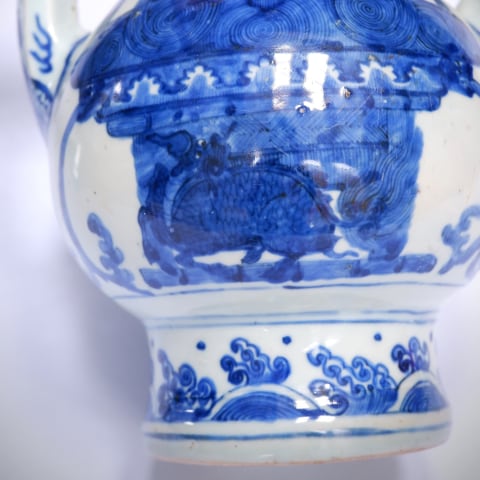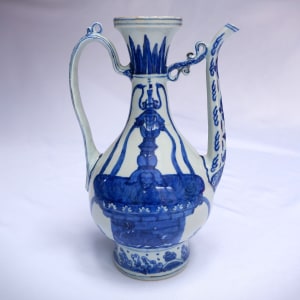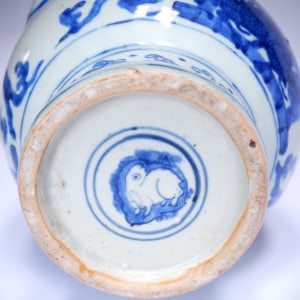A RARE CHINESE BLUE AND WHITE 'MAGIC FOUNTAIN' EWER, Jiajing (1522-1566)
Height: 32cm; 12 ½ ins.
BH69
BH69
Further images
The pear-shaped body supported on a tall circular foot, the slender neck rising to an everted rim, set with a tall spout and an elegant looping bracket handle, decorated in...
The pear-shaped body supported on a tall circular foot, the slender neck rising to an everted rim, set with a tall spout and an elegant looping bracket handle, decorated in rich shades of underglaze cobalt, finely painted on each side of the body with a fountain issuing water which flows from fantastic animal head spouts, a kylin prances below the basin, the neck with upright plantain leaves, the foot with crashing waves, the glazed base painted with a crouching hare reserved against a leaf within a double circle in underglaze blue.
Provenance
Field Marshal Earl Kitchener of Khartoum (1850-1916), and thence by descent through the family. This ewer is recorded in the Christie, Manson & Woods inventory at Broome Park, in December 1916 on page 39, where it is located in the Hall and described as 'An ewer, painted with fountains in the Persian taste; early type. 13in. high'.Literature
The Jiajing emperor was preoccupied with immortality. Porcelain created during his reign often bears decorative motifs associated with longevity. By drinking from the 'magic fountain', one could live forever without becoming old, and thereby drinking from a ewer bearing this motif would have the same effect !By the middle of the 17th century, these ewers were also prized objects among Europeans as can be seen in a ewer bearing the 'magic fountain' motif features in a still life oil painting by Willem Kalf, c. 1660, in the Museo Nacional Thyssen-Bornemisza, Madrid (ac.no.1981.77).
The origin of the design of this ewer is buried in the mists of time and has been the subject of much research. The shape is inspired by Near Eastern brass pitchers.
A 16th century blue and white ewer with a similar design is illustrated by J. Pope, Chinese Porcelains from the Ardebil Shrine, London, 1981, pl.99. A similar blue and white ewer is in the Victoria and Albert Museum, London (accession no. C.105-1928).
There is also a very similar blue and white 'magic fountain' ewer illustrated by Jessica Harrison-Hall in the Catalogue of Late Yuan and Ming Ceramics in the British Museum, London, 2001, p. 221, no. 9:10. Harrison-Hall suggests that ewers of this design may have been commissioned by Jesuits who lived in Macao from the mid-sixteenth century, and who were involved in the making of Chinese porcelain.
According to Linda Rosenfeld Shulsky ('The Fountain Ewers: An Explanation for the Motif', Museum of Far Eastern Antiquities Bulletin, no. 67, Stockholm, 1995, pp. 49-78), there are a number of aspects of Christian iconography which could account for the appearance of fountains on these ewers.
A Jiajing 'magic fountain' ewer of similar size and bearing the mark of the period is held in the collection of, Chinese Ceramics in the Topkapi Saray Museum, Istanbul, illustrated in vol.2, no.1013, inv. TKS 15/1462.
Quoting Regina Krahl and John Ayers. Topkapi Saray vol.2 p.654:
'This fountain design is discussed in an article by Sir Percival David (The magic fountain in Chinese ceramic art; An exercise in illustrational interpretation, published by Museum of Far Eastern Antiquities, 1952), where he relates it to a 'Magic Fountain' of similar appearance, distributing various kinds of drinks upon request. This fountain is reported to have been built by the Parisian goldsmith Guillaume Bouchier for Mangu Khan at Karakoram in 1254. Suzanne G. Valenstein supports Sir Percival's theory by illustrating a 14th century handscroll depicting an imaginary view of the Da Ming palace of the Tang dynasty; this includes an elaborate balustraded fountain where the water is similarly pouring from monster masks, that could have been inspired by Bouchier's actual construction (New York, China House Gallery, 1970-71, fig.4).
'Pope however disagrees with this interpretation and believes a contemporary fountain of the Italian Renaissance to be the model (1956, pp.134-6). This seems more likely. 'One such 'fountain ewer' is in the Iran Bastan Museum, Teheran, from the Ardebil Shrine: Pope, 1956, pl. 99.






